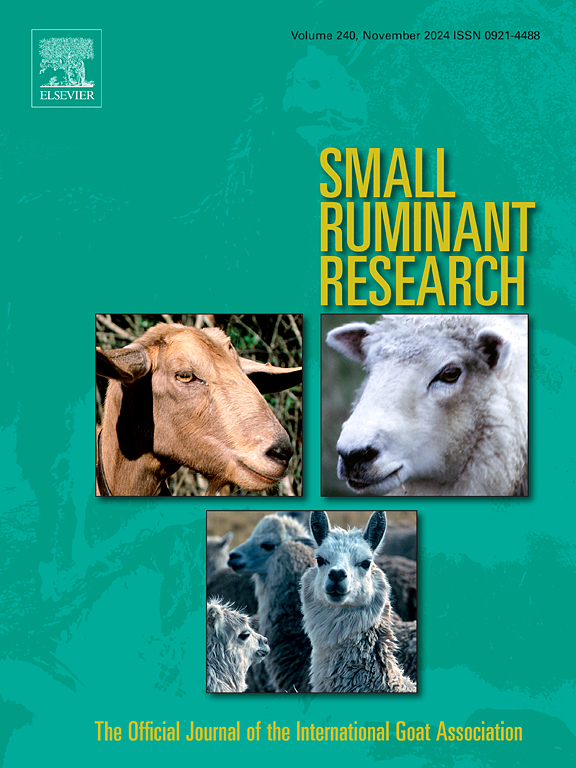Body temperature and heart rate variability, and their circadian rhythms in sheep as measured by biologgers
IF 1.6
3区 农林科学
Q2 AGRICULTURE, DAIRY & ANIMAL SCIENCE
引用次数: 0
Abstract
Heart rate (HR) variability (HRV) reflects the balance between the autonomic nervous system's sympathetic and parasympathetic branches, which regulate stress and relaxation. Wearable sensors record HR and body temperature (BT), to provide data that informed decisions can be made from on animal management and welfare. The purpose of this study was to investigate daily changes in BT and HRV, recorded by subcutaneous biologgers; specifically, to quantify the 24-hour circadian rhythm in BT (°C), HR (bpm), the Standard Deviation of the R-R intervals (SDNN), and the Root Mean Square of Successive Differences (RMSSD) (ms). Five ewes were implanted with a subcutaneous biologger, configured to collect data every 5 min for 7 d. Mean ( ± S.E.) BT (38.06 ± 0.01), HR (111.14 ± 1.68), SDNN (34.35 ± 2.90), and RMSSD (47.95 ± 4.21) were calculated. BT and HR were highest in the day (day: 38.15 ± 0.01 and 120.71 ± 0.43; night: 37.98 ± 0.01 and 102.47 ± 0.43; P < 0.001), and SDNN (day: 29.30 ± 0.87; night: 37.16 ± 0.67) and RMSSD (day: 39.01 ± 1.17; night: 53.53 ± 0.94) were highest at night (P < 0.001). BT and HR were positively correlated (P < 0.01), but both negatively correlated (P < 0.01) with SDNN and RMSSD. BT, HR, SDNN, and RMSSD presented a 24-h circadian rhythm, with acrophases (peak activity period) for BT at 1457 h and at 1223 h for HR, but those of SDNN and RMSSD were at 0350 h and 0327 h, respectively. In conclusion, biologgers detected the diurnal rhythmicity in BT and HRV in sheep, providing an option to use these physiological measures to assess an animal's health and welfare.
由生物学家测量的羊的体温和心率变异性及其昼夜节律
心率(HR)变异性(HRV)反映了自主神经系统交感神经和副交感神经分支之间的平衡,它们调节压力和放松。可穿戴传感器记录人力资源和体温(BT),为动物管理和福利方面的明智决策提供数据。本研究的目的是调查由皮下生物学家记录的BT和HRV的每日变化;具体来说,量化24小时昼夜节律的BT(°C)、HR (bpm)、R-R区间的标准差(SDNN)和连续差的均方根(RMSSD) (ms)。5只母羊植入皮下生物学仪,每5 min采集一次数据,持续7 d。平均值( ± S.E.) BT(38.06±0.01 )、人力资源(111.14 ±1.68 ),SDNN(34.35 ±2.90 ),和RMSSD(47.95 ± 4.21)计算。BT和HR在白天最高(白天:38.15 ± 0.01和120.71 ± 0.43;夜间:37.98 ± 0.01和102.47 ± 0.43;P <; 0.001)和SDNN(日:29.30 ± 0.87;夜间:37.16 ± 0.67)和RMSSD(白天:39.01 ± 1.17;夜间:53.53 ± 0.94),夜间最高(P <; 0.001)。BT与HR呈正相关(P <; 0.01),与SDNN、RMSSD均呈负相关(P <; 0.01)。BT、HR、SDNN和RMSSD呈24 h昼夜节律,其中BT的峰期(活动高峰)分别为1457 h和1223 h,而SDNN和RMSSD的峰期分别为0350 h和0327 h。总之,生物学家在绵羊中检测到了BT和HRV的昼夜节律,为使用这些生理指标来评估动物的健康和福利提供了一种选择。
本文章由计算机程序翻译,如有差异,请以英文原文为准。
求助全文
约1分钟内获得全文
求助全文
来源期刊

Small Ruminant Research
农林科学-奶制品与动物科学
CiteScore
3.10
自引率
11.10%
发文量
210
审稿时长
12.5 weeks
期刊介绍:
Small Ruminant Research publishes original, basic and applied research articles, technical notes, and review articles on research relating to goats, sheep, deer, the New World camelids llama, alpaca, vicuna and guanaco, and the Old World camels.
Topics covered include nutrition, physiology, anatomy, genetics, microbiology, ethology, product technology, socio-economics, management, sustainability and environment, veterinary medicine and husbandry engineering.
 求助内容:
求助内容: 应助结果提醒方式:
应助结果提醒方式:


